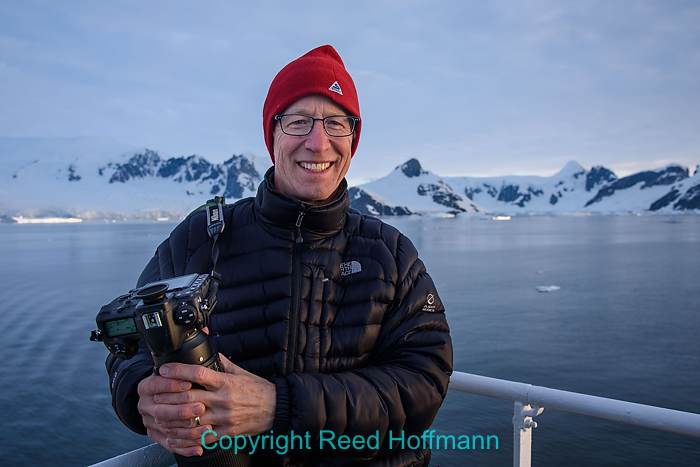In the summer of 2015 I was the photographer on a ship in the Arctic, and the staff there kept telling me if I liked the Arctic, I’d love the Antarctic. They were right. This January I led a photography workshop to the Antarctic Peninsula on a One Ocean Expeditions ship (the Vavilov) for Pack Paddle Ski. When people ask me what it was like being down there, I find it difficult to describe. Big. Remote. Barren. An endless landscape of water, ice and snow. But at the end, what I end up telling them is, “It was beautiful.” Those Antarctic memories will last a lifetime.
Because of weight restrictions, I took just two cameras (Nikon D500 and D750) and three Nikkor lenses (18-35 f/3.5-4.5, 24-120mm f/4 and 200-500mm f/5.6). I brought just three batteries, eight 64-GB SD cards and a 13-inch MacBook Pro. For the travel down and back all of that was in my Thinktank Airport Essentials backpack, and while shooting I worked out of a Thinktank Speed Demon beltpack. Going to and from the ship in the Zodiacs, I could put my gear in a dry-bag to protect it from spray. But most of the time, though, the water was calm enough and the Zodiac moving slowly enough that I could keep the cameras out and take pictures.
The ship can carry about 100 passengers, with a staff of 22 and ship’s crew of 44. Cabins went from fairly basic shared (with bathrooms down the hall) to some very nice suites. Meals were good (a little too much, probably), and we had lots of lectures we could attend on everything from bird and sea life to history. The presentation room was also available for our group to use, so I gave three lectures on photography. The ship also supplies boots and foul weather gear (heavy overalls and coats), and does laundry on board. So we didn’t need to bring large amounts of clothing. And since it’s summer down there this time of year, temps tended to be in the 20s and 30s, which was warmer than back home for a lot of people! And, while you can get a shipboard email account, it’s text only and slow. No surfing internet, updating Facebook, etc. Which was actually very nice. Most of us actually thought it was pretty nice to be disconnected for a while.
Returning home after being gone nearly three weeks, there was a lot to get caught up on. Which meant the photos had to wait. Now, though, I’ve had time to work through them, and here are some of my favorites and the stories behind them.
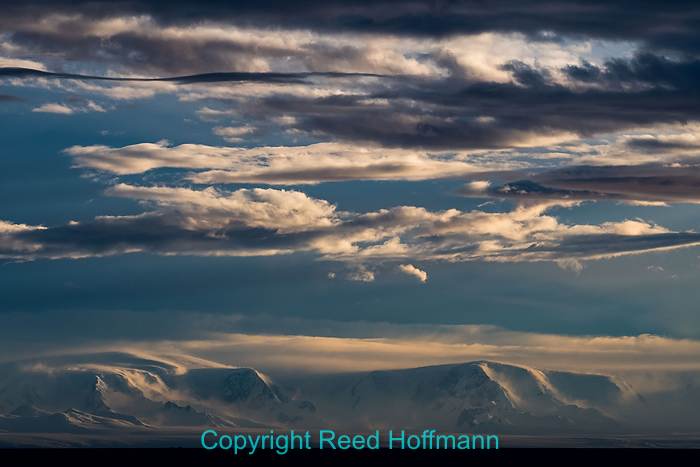
First off, the landscapes are incredible. No contrails, no power lines, no signs of people. The snow and ice-covered mountains rise to 10,000-ft and above. And while there is night-time, that period is only a few hours, and it never truly got dark. This was at 9:30 at night, so sunset was still about two hours away. I loved the soft light on the mountains contrasting against the hard light above. Nikon D500, ISO 500, 1/1250 at f/7.1, EV at 0.0, Nikkor 200-500mm f/5.6 lens at 200mm. Photo copyright Reed Hoffmann.
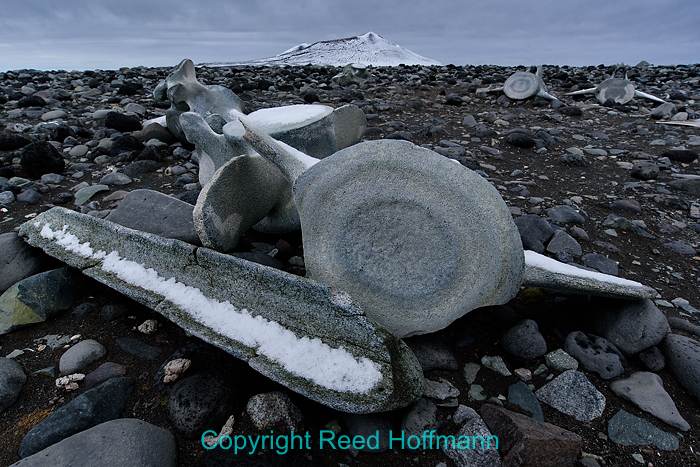
Our first landing was at Turret Point. Which meant it was our first face-to-face encounter with penguins, fur seals and elephant seals. But what really hit me were the whale bones. Nearly hunted to extinction, whales were pursued to the ends of the earth, including the Antarctic. From a distance, these whale vertebrae looked like large tree stumps. Getting close with my wide-angle, I was able to show the detail and texture, plus the fresh snow, while still having a background of more bones and a mountain. Nikon D750, ISO 200, 1/200 at f/11, EV at +0.3, Nikkor 18-35mm f/3.5-4.5 lens at 20mm. Photo copyright Reed Hoffmann.
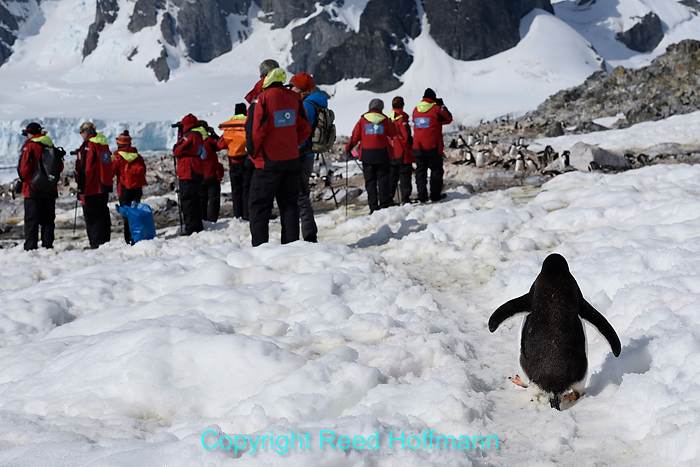
We made several landings at penguin colonies, and this one was to see Gentoos on Cuverville Island. The penguins mostly ignore visitors as they don’t see them as a threat. We’re told not to approach closer than 15-ft, but they will sometimes walk right up to you. Here a group is watching thousands nesting on the rocks, oblivious to the one coming up behind them. Nikon D750, ISO 200, 1/1600 at f/8, EV at 0.0, Nikkor VR Zoom 24-120mm f/4G lens at 66mm. Photo copyright Reed Hoffmann.
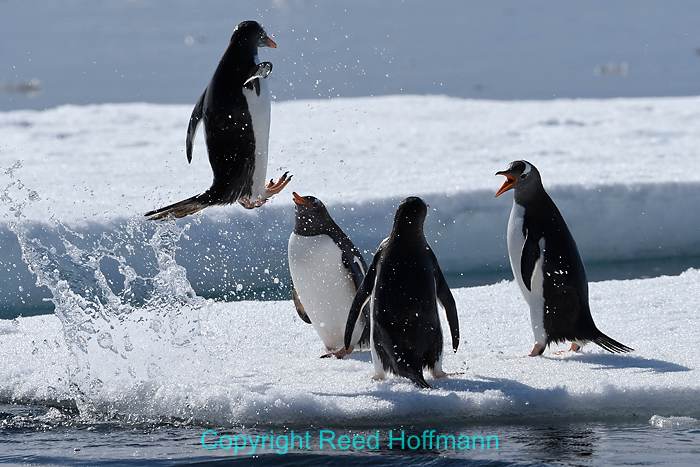
Aside from looking adorable, there were two things I loved about watching the penguins. This is one of them. They’re fast swimmers, and when they want to come out onto ice, they shoot out of the water and land on their feet. Or at least try to land on their feet. This is a hard picture to make because you don’t know where they’re going to pop out, and by the time you see it, you’re too late. Patience paid off, though. Watching for a while, we saw there was one place they’d regularly come flying out. So I simply kept my lens on that spot and waited. I like how the others look like they’re rating the one in the air. Nikon D500, ISO 200, 1/1600 at f/8, EV at 0.0, Nikkor 200-500mm f/5.6 lens at 390mm. Photo copyright Reed Hoffmann.
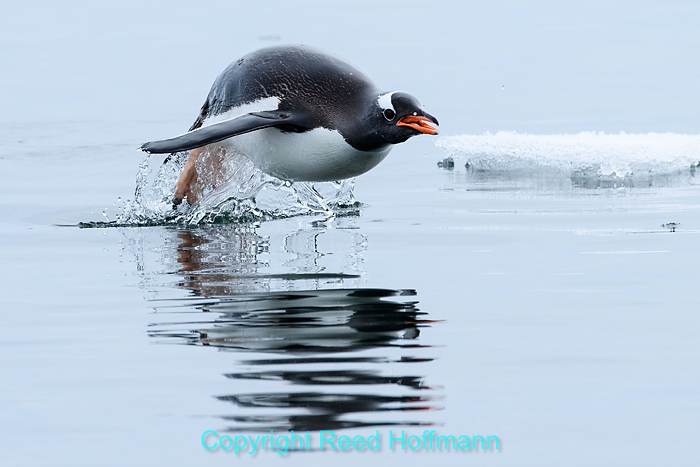
This is the other thing penguins do that I love. They “porpoise” through the water while swimming. Another hard picture to make, I probably shot over five-hundred frames trying to get a few good ones over the course of the trip. Shooting digital lets me shoot, shoot, shoot to try to get that one shot. And the ten-frames-per-second of the D500 sure helps! Nikon D500, ISO 450, 1/1600 at f/8, EV at +0.3, Nikkor 200-500mm f/5.6 lens at 380mm. Photo copyright Reed Hoffmann.
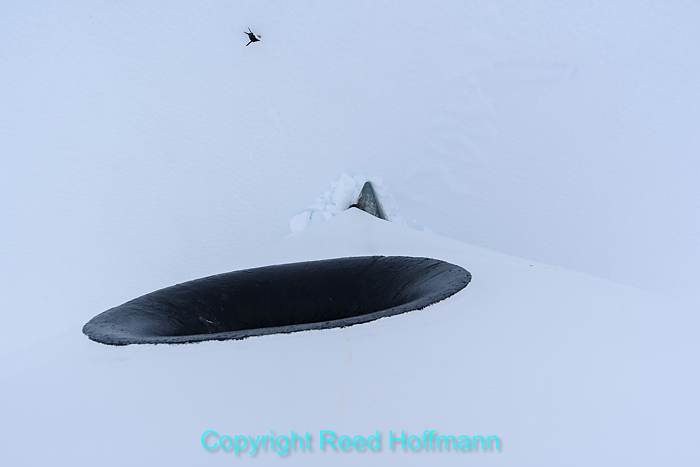
Early in the trip the expedition leader told us that if conditions worked out, they’d try to give us a chance to land on an ice sheet. This was that day, and as the ship “parked” it’s nose into the ice, a penguin was walking by. To make this shot I had to hold the camera out over the railing – I couldn’t get this angle with the camera to my eye. It’s one of my favorite photos from the trip. Nikon D750, ISO 200, 1/2000 at f/8, EV at 0.0, Nikkor 18-35mm f/3.5-4.5G lens at 18mm. Photo copyright Reed Hoffmann.
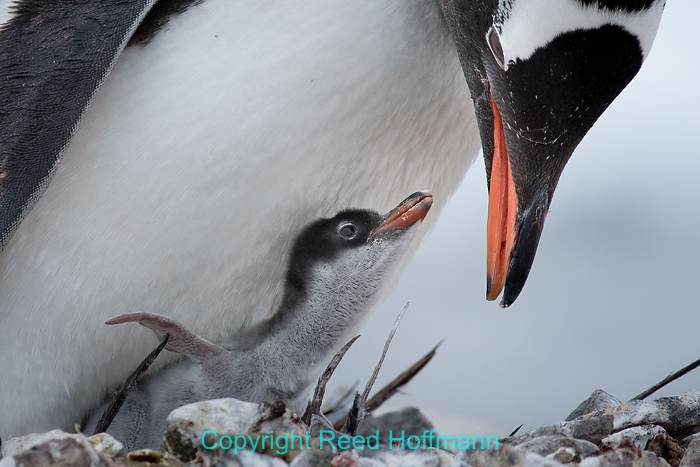
Penguins build nests out of rocks, and usually lay two eggs. Most of those eggs had hatched by the time we got there, so plenty of chicks to see. The best moments occurred when there was interaction between the chick and parent. Nikon D500, ISO 360, 1/1250 at f/6.3, EV at +0.3, Nikkor 200-500mm f/5.6 lens at 500mm. Photo copyright Reed Hoffmann.
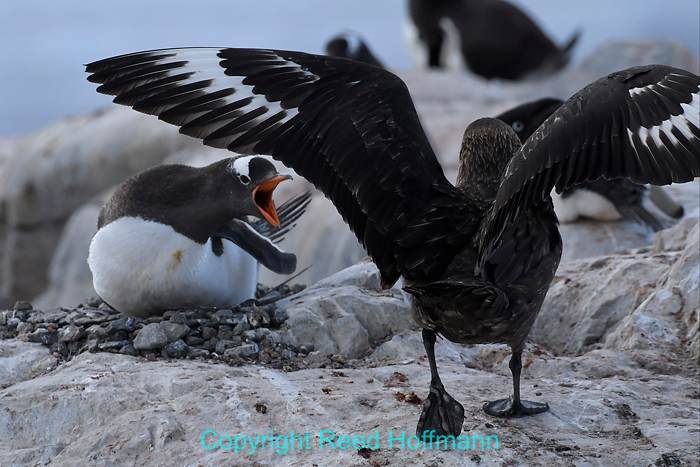
Skuas (the bird at right) will steal penguin chicks if they can, so anytime one was near, the adult penguins were on high alert. They’ll also eat the penguin eggs, and we saw the aftermath of that too. It’s sad, but Skuas have to eat too. Nikon D500, ISO 560, 1/1600 at f/7.1, EV at 0.0, Nikkor 200-500mm f/5.6 lens at 480mm. Photo copyright Reed Hoffmann.
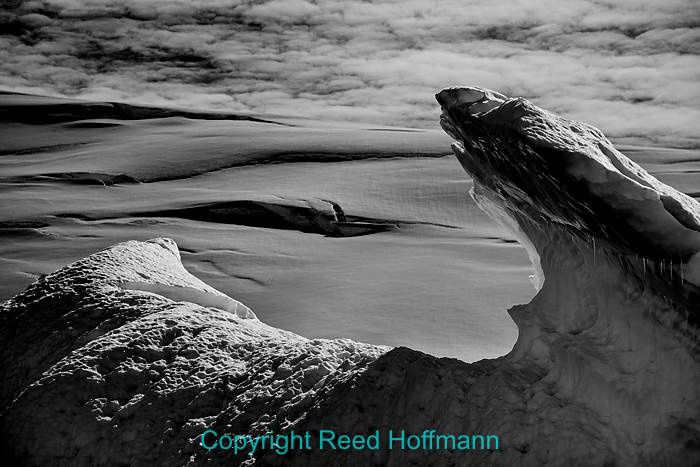
The icebergs and “growlers” and “bergie bits” (smaller pieces) were fascinating, like nature-sculpted works of art. The range of blues they exhibit can be almost other-worldly, but at times, I thought the shape, lines and light were more important. This was one of those times, so I chose to convert the image to black and white. Nikon D750, ISO 100, 1/1600 at f/7.1, EV at -0.3, Nikkor 24-120mm f/4G lens at 120mm. Photo copyright Reed Hoffmann.
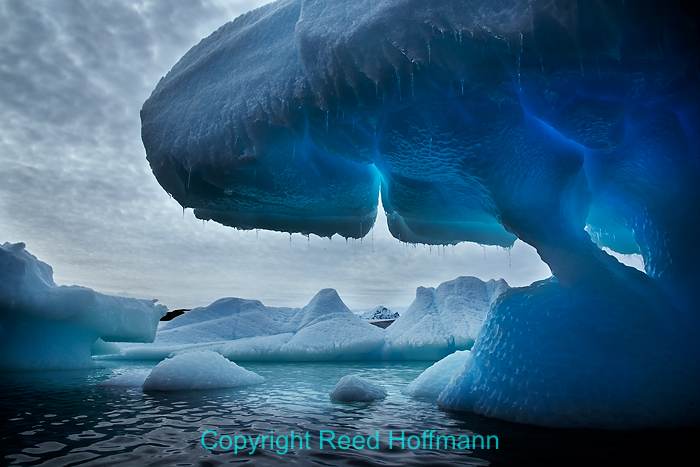
On the other hand, there were times where I wanted to keep that color, just because of how unusual it is. You can’t get close to large icebergs, because if they rolled, that would be bad. Very bad. But smaller ones, like this, we could sometimes get very close to. I made this picture hanging over the side of the Zodiac, with the camera just inches above the water, framing with the LCD of the camera flipped out. Nikon D750, ISO 200, 1/400 at f/11, EV at +1.0, Nikkor 24-120mm f/4G lens at 24mm. Photo copyright Reed Hoffmann.

So much of photography is about light and shadow, and with so much white in the Antarctic, that’s even more pronounced there. In this scene, the dark water and sky, with the only sunlight on the side of this mountain, makes for a dramatic picture. This is also a great example of why I like to carry two cameras with different size sensors. For this trip I had the D500, with a DX sensor (“cropped” sensor) and the D750 FX camera (full-frame sensor). The 200-500mm lens spent most of the trip on the D500, because for wildlife I prefer the tighter framing that sensor gives me. But in this case, 200mm was too tight on my D500, so I switched the lens to the D750. That looser framing let me crop the photo in-camera just the way I wanted. Nikon D750, ISO 200, 1/800 at f/6.3, EV at -0.3, Nikkor VR Zoom 200-500mm f/5.6 lens at 240mm. Photo copyright Reed Hoffmann.
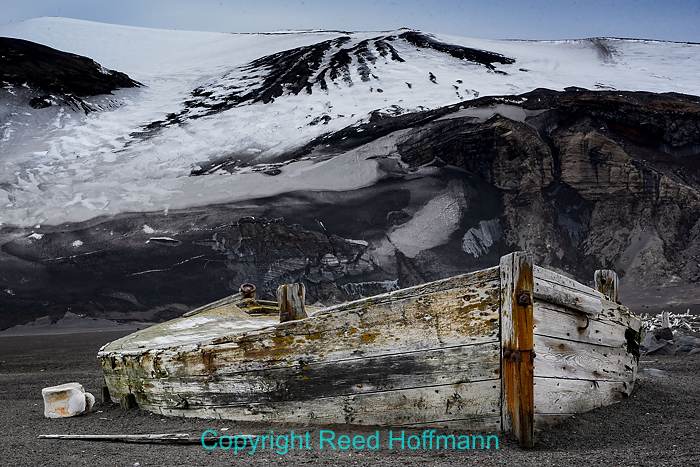
Because of the harsh environment, there are few signs of human habitation in the Antarctic. One place we did see some, though, was at Whaler’s Bay on Deception Island. Once a haven for whaler’s, there are remains of that time slowly disappearing from its shores. Not carrying a tripod, I simply sat on the sand and braced my elbows on my knees. That let me stay at a low ISO and small aperture, yet still get a sharp picture despite the slow shutter speed. Nikon D750, ISO 160, 1/80 at f/16, EV at +0.3, Nikkor 24-120mm f/4G IF-ED lens at 65mm. Photo copyright Reed Hoffmann.
(If you like this story, please share it with your friends, and let them know about the links on photography I post on my business Facebook page. I’m also on Instagram @reedhoffmann)

